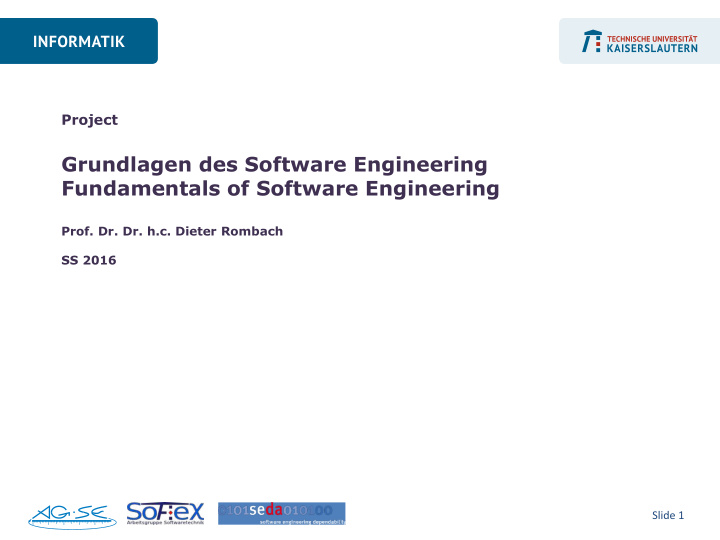



Project Grundlagen des Software Engineering Fundamentals of Software Engineering Prof. Dr. Dr. h.c. Dieter Rombach SS 2016 Slide 1
Organizer Prof. Dieter Rombach Malte Brunnlieb rombach@informatik.uni-kl.de m_brunnl@cs.uni-kl.de 32-423 32-432 0631 / 205 – 26 25 Anne Hess Anne.Hess@iese.fraunhofer.de 0631 / 6800 - 2104 Sebastian Müller Christian Wolschke sebastian.mueller@cs.uni-kl.de wolschke@cs.uni-kl.de 32-429 32-419 0631 / 205 – 34 49 0631 / 205 – 33 33 Slide 2
Topics Goal Project Applied Techniques Infrastructure Slide 3
Goal Apply engineering methods and techniques for the systematic development of software-intensive systems Component Requirements Architectural design Testing Engineering Engineering & Interaction Design Slide 5
Project This year’s project will deal with the development of a mobile people’s bus system. The systems consists of a mobile app that serves as the people’s bus host system and another mobile app for citizens to use the different people’s busses. It is intended, that the system will be used within the project Digitale Dörfer (for further information see www.digitale-doerfer.de). Real life evaluations with concrete existing people’s bus systems are also optionally possible. Steffen Hess Steffen.Hess@iese.fraunhofer.de 0631 6800 2275 Slide 6
Bürgerbus Weilerbach Slide 7
Applied Techniques Project Organization n Project Organization 2 Project Organization 1 Product Project Project Goal and Planning Plan Character- istics Project Management SW- AD CO Test Problem RE / ID System/ / Rqmts Product Quality Assurance Storage Reuse Reuse (Models) (Products, Measures) Experience Factory - T/M/T Storage - Products - Products - Project plans - Data Process- Product- Quality- - […] - […] models models models Experience Database Project Database RE: Requirements Engineering ID: Interaction Design Slide 8 AD: Architecture Design CO: Coding
Applied Techniques Project Organization n Project Organization 2 Process Modeling (MVP-L) Project Organization 1 Req-Mgmt Product Project Project Goal and Planning Plan Character- Stepwise istics Abstraction mConcAppt Project Management SW- AD CO Test Problem RE / ID System/ / Rqmts Product MIL Testing Quality Assurance Inspections Version with PBR Mgmt Storage Reuse Reuse (Models) (Products, Measures) Experience Factory - T/M/T Storage - Products - Products - Project plans - Data Process- Product- Quality- - […] - […] models models models Experience Database Project Database RE: Requirements Engineering ID: Interaction Design Slide 9 AD: Architecture Design CO: Coding
Github-Wiki Applied Techniques Git-Repo Project Organization n Project Organization 2 Process Modeling (MVP-L) Project Organization 1 Req-Mgmt Product Project Project Goal and Planning Plan Character- Stepwise istics Abstraction mConcAppt Project Management SW- Arch Co Test Problem RE / ID System/ / Rqmts Product MIL Testing Quality Assurance Inspections Version with PBR Mgmt Storage Reuse Reuse (Models) (Products, Measures) Experience Factory - T/M/T Storage - Products - Products - Project plans - Data Process- Product- Quality- - […] - […] models models models Experience Database Project Database RE: Requirements Engineering ID: Interaction Design Slide 10 AD: Architecture Design CO: Coding
Supervision Steffen Hess Christian Anne Hess Sebastian Malte Wolschke Müller Brunnlieb New feature Project Requirements Entries in Architecture requests Management Engineering / Wiki for test Interaction reports Git commits Issue Tracker Design with mConcAppt Test cases Jenkin builds in Wiki Code Slide 11
Infrastructure • Project environment is provided • Technical support: Christian Wolschke, Thomas Schneider Thomas Schneider tschneid@cs.uni-kl.de 32-418 Slide 12
Project Management Kick-off Meeting 4 Iterations Each iteration consists of Requirements & Interaction Design PBR: Test cases and customer interview Architecture Checklist-based review Coding Code reviews Testing Each iteration ends with testate Final Presentation with Prof. Rombach Date: t.b.d. Slide 13
April May June July Project Management CW 14 15 16 17 18 19 20 21 22 23 24 25 26 27 28 29 30 Iter 1 1 1 1 1 Req +Des 1 1 Co 1 QA 1 Iter 2 2 2 2 Req +Des 2 Co 2 QA 2 Iter 3 3 3 3 Req +Des 3 Co 3 QA 3 Iter 4 4 4 4 Req +Des 4 Co 4 QA 4 Buffer X Slide 14 Finalize X
Workflow (1) Create New Prioritize Track Assign for next step Idea (-> milestone) changes Issue document related Requirements artifacts + changes Engineering System TC Stakeholders Goals Create System Test Interview Customer Use Cases Cases System Functions System Designing Checklist based Architecture review Slide 15
Workflow (2) Architecture Unit Designing Issue Unit interface + Create Unit Test document related specification Cases artifacts + changes Coding Unit TC Code Review Automatic build + Unit Test build artifacts Slide 16
Requirements Engineering & Interaction Design See „mConcAppt@GSE2016.docx“ for detailed guideance Specify usage scenarios Create clickable prototype Conduct user review Phase 3 Validate Interaction Design Phase 2 Specify Interaction Design Identify key functionality Phase 1 Elicit Specify Interaction Cases Requirements Model flow of interaction cases Create Wireframes Model screen flows Prepare & Conduct Workshop Document Results Slide 17
Architecture Open Application Standard Platform Trace system functions to components (see MIL) Slide 18
Coding Coding conventions Unit test frameworks Lanuages: Java Angular JS Git for source code management (SCM) Jenkins for automatic builds Slide 19
Testing Test by unit tests and system tests Report tests Rework if necessary Slide 20
Your work • You will work in teams Please register until March 20, 2016 at Christian Wolschke We will inform you, whether you can participate (as we have 15 places available) • You will only be able to finish your tasks if you continuously work on them • 8 ECTS Points -> 240 hours, 13 weeks -> ~ 18,5 hours/week Slide 21
Next steps Sign participation declaration you agree your result to be public and reusable Get access to our lab Physical keys Get access to PCs in lab Github project Jenkins-Server Read guidelines for working Start to work Slide 22
Recommend
More recommend